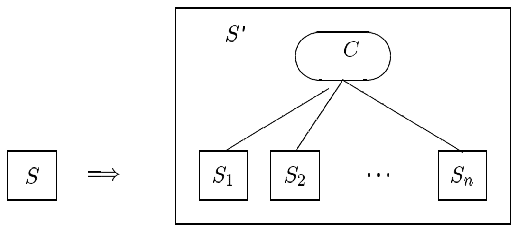Consider a system S of any kind. Suppose that there is a way to make some number of copies from it, possibly with variations. Suppose that these systems are united into a new system S' which has the systems of the S type as its subsystems, and includes also an additional mechanism which controls the behavior and production of the S-subsystems. Then we call S' a metasystem with respect to S, and the creation of S' a metasystem transition. As a result of consecutive metasystem transitions a multilevel structure of control arises, which allows complicated forms of behavior.

We refer to the original system S as the scope of the MST, and to the number of integrated systems as its scale. The minimal scale of an MST is one. In this case there is no reproduction of the scope, but a control level still emerges, so it is a metasystem transition.
In a multilevel control system each level is associated with a certain activity which is characteristic for this level. Each metasystem transition creates a new type of activity. If A is the activity on the top level of control in some system, then in a metasystem transition a new activity emerges: that of the new control level. Let it be referred to as A'. It can be described as controlling the activities A of the level which now is penultimate:
control of A = A'
This is a functional description of a metasystem transition, which allows us to pinpoint a metasystem transition even in those cases where we do not know the exact structure of the systems involved.
Some Examples
The classic example of an MST is the emergence of multicellular organisms. Here system S is a living cell, which can survive on its own. Reproduction of cells and their integration into a metasystem creates S', an organism of a new kind, which may consist of thousands and millions of cells. At the beginning of this process the control mechanism is quite rudimentary: just holding cells together. It takes place due to the laws of nature, without any spatially separated substructure. But in the course of further metasystem transitions, specialization of cells occurs, and we witness the creation of a multilevel hierarchy of structures and functions, where cells are integrated into tissues, tissues into organs, organs into an organism, and all this is controlled by the humoral and nervous systems (for further examples, see Metasystem transitions in biology).
Formation of the human society from individuals is also an MST. As in the case of multicellular organisms, the scope S of the transition is the whole system under consideration. This is not always so. A metasystem transition can take place over a scope which is a substructure of the considered system. Thus, formation of an army from conscripts is a typical MST resulting in a hierarchy of control, but the units which are integrated are individual conscripts, not whole societies. A more important example of this kind is the metasystem transition within the brain which resulted in the emergence of the human being.
The history of computer technology gives us more examples of MSTs. At its beginning we find von Neumann's idea: to keep and treat programs as data. In a mechanical calculator, no matter how it is designed, the top level in functional description is execution of four arithmetic operations. In von Neumann's computer this level is also present, but there is a higher level: the program, which controls the operations to be executed by hardware. We see two levels of control instead of one: a metasystem transition. (Of course, when we speak of instruments, such as computers, the control hierarchy always has the human user on the top, so we may not mention it).
The next MST in the use of computers was the introduction of formal machine-independent languages for programming; Fortran was the first. Now the computer program is no more the top of hierarchy. The top is a translator which reads the Fortran program written by the user, and compiles the necessary computer program: three levels of control.
Evolution
As in all evolutionary developments, the most important events are metasystem transitions.
In "The Phenomenon of Science" (Columbia University Press, 1977) it is shown that the major steps in evolution, both biological, and cultural, are nothing else but metasystem transitions of a large scale. The concept of metasystem transition allows us to introduce a kind of objective quantitative measure of evolution and distinguish between evolution in the positive direction, progress, and what we consider an evolution in the negative direction, regress (cf. the direction of evolution).
For example, here is the sequence of metasystem transitions which led, starting from the appearance of organs of motion, to the appearance of human thought and human society:
- control of position = movement
- control of movement = irritability (simple reflex)
- control of irritability = (complex) reflex
- control of reflex = associating (conditional reflex)
- control of associating = human thinking
- control of human thinking = culture
For more details, check "The Quantum of Evolution", a collection of papers on the topic of metasystem transitions, published as a special issue of "World Futures".

